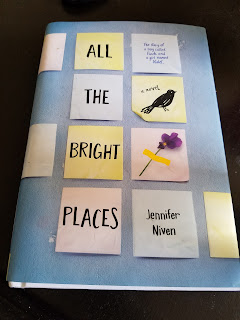YA Novel All the Bright Places Squashes 1 Stigma While Perpetuating Another
 I recently completed Jennifer Niven's, All the Bright Places. The book addresses mental illness and suicide in the scope of young adults. Sadly both of these are issues that effect everyone and I commend the author for bringing focus to the stigma that surround both mental illness and suicide. It is a book that I'm sure has helped many who have found themselves in a position of loss, however I have an issue with All the Bright Places.
I recently completed Jennifer Niven's, All the Bright Places. The book addresses mental illness and suicide in the scope of young adults. Sadly both of these are issues that effect everyone and I commend the author for bringing focus to the stigma that surround both mental illness and suicide. It is a book that I'm sure has helped many who have found themselves in a position of loss, however I have an issue with All the Bright Places.
An issue that is too often found in YA fiction. It's as if there is an array of teenagers; sick teenagers, promiscuous teenagers, differently-abled teenagers but not many of those are people of color or more than one label. It is an over simplification that makes YA a genre that too often fights to be taken seriously.
It is a total of 4 sentences, in a book that is 378 pages long, yet those 4 sentences continue to resurface as I fall in love with tortured Theodore Finch and forever-changed Violet Markey. Those four sentences where the author chose to describe a character in a way that none of the other characters were subjected to.
Why would race be thee only characterization for one character while we never gain this racial insight into any of the others? Is that because one is deemed as exotic or is it because if you are anything but "white" then it is necessary that your race be mentioned?
What is to be learned from saying they are black? Better question, why do we assume that everything can be learned from hearing someone's "race" ? This device does not hold true however if that someone is labeled as "white." We then adopt the opposite approach, meaning nothing can be assumed by learning that they are white. Rather it doesn'the bare mentioning. It is so ordinary, so boring, so normal. Isn't that what the author is conveying by only mentioning the race of one character throughout the entire novel?
Throughout the story we hear about Finch's pale skin where you can see his veins. It paints a vivid picture of this young man with the bright blue eyes and dark hair. It is worded masterfully and intersects with the development of the character while Charlie Donahue is only a racial category. Yes I learn that he is a playboy, a joker, a realist but that wasn't acquired through the antiquated description of "black-black." It was due to dialogue. It was portrayed through his witty comments, his acceptance of Finch, his easy demeanor. Niven painted the picture of who he was with her polished prose, no offensive comment required.
Describe skin color if you are compelled, tell me their nationality, where are they from, how do they identify? Don't lazily plug in a racial category that has no bases in either hard or soft science and expect me to gain any real understanding of your POV.
Describe skin color if you are compelled, tell me their nationality, where are they from, how do they identify? Don't lazily plug in a racial category that has no bases in either hard or soft science and expect me to gain any real understanding of your POV.
I'm not expecting Jennifer Niven to be an expert on everything, or to tackle every social issue in each of her published works. I'm simply saying that if we are going to address these pivotal issues why not be inclusive? Why not allow the reader to see themselves in these poignant characters? Mrs. Niven, your readers are diverse. If all you create are well developed, animated white characters and make our representation a vacant farce you are committing a grave injustice. Presenting an image that fuels the disparities in our society by only enlisting "white" characters to tell these stories. It only further perpetuates the feeling that diverse readers experiencing things like mental illness or suicide, are in fact alone.
In short, help me see what you see but I suppose I have. Jennifer Niven it is through your eyes that I see that suicide and mental illness are not issues to be taken lightly. I see that moody is not synonymous for bi-polar disorder, that we can overcome grief and that there are two types of black people, CW and black-black. I see that black men belong in athletics and that if you know my race, you then know everything about me.
*Screenshot of the tweet I sent Jennifer Niven to no avail. I strongly regret the smiley face emoji but I really thought that it would help garner a response because I don't want her to feel attacked. I just want her to be aware that thousands of teens are reading her work and they need to know that in 2016 it is no longer tolerable to describe others with one word as if that would suffice. We are humans. We are complex, multifaceted, adaptable, diverse, and beautiful. We are more than one word.



Bravo!
ReplyDelete